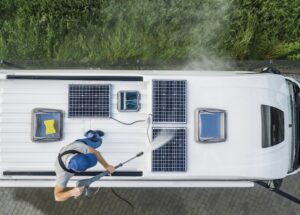Expert Tips to Maintain Your RV’s Roof
Keeping your RV roof in great condition is one of the most important parts of protecting your investment. Whether you travel full-time or take seasonal trips, your roof is constantly exposed to sun, rain, wind, tree sap, and debris, all of which can lead to cracks, sealant failure, and water intrusion if neglected. Fortunately, a little preventive maintenance goes a long way. At Ron’s Auto & RV in Vancouver, WA, we’ve repaired every type of RV roof damage imaginable, and we’re here to help you avoid costly repairs with proper care.
Understanding the Different Types of RV Roofs
Before diving into maintenance tips, it’s helpful to know what kind of roof your RV has. Each material has its strengths and weaknesses:
Rubber (EPDM or TPO)
Rubber roofs are lightweight and flexible, making them one of the most common materials used in modern RVs. EPDM is slightly softer and more textured, while TPO is smoother and brighter white. Rubber roofs resist UV rays well but can be punctured by sharp branches or degrade if harsh chemicals are used during cleaning.
Fiberglass
Fiberglass roofs are durable and rigid, often found on higher-end RV models. They’re resistant to dents and tears but can develop stress cracks over time. When damaged, fiberglass repairs can be more expensive than rubber.
Aluminum
Aluminum roofs are typically found on older RVs and Airstream-style trailers. They are strong against hail and physical damage but prone to corrosion and seam leaks if not properly sealed.
Knowing your roof type helps you choose the right cleaners, sealants, and repair products.
Common RV Roof Problems to Watch For
Even the toughest RV roof can fail if ignored. Here are the most common issues:
- Cracked or dried-out sealant around vents, skylights, and seams
- Punctures from low-hanging branches or debris
- UV damage, causing fading or brittleness
- Pooling water, especially on flat rubber roofs
- Loose roof trim or lifted edges
Catching these problems early prevents serious water damage that can spread into insulation, ceilings, and interior panels.
Essential RV Roof Maintenance Tips

Here’s how to extend the life of your RV roof and avoid leaks:
1. Clean the Roof at Least Twice a Year
Use a manufacturer-approved cleaner or mild soap with a soft brush. Avoid petroleum-based or abrasive cleaners, especially on rubber roofs. Regular cleaning removes grime and allows you to inspect for damage more easily.
2. Inspect All Seams and Sealant
Check around vents, skylights, antennas, and roof edges. If the sealant is cracked, peeling, or loose, scrape it off carefully and apply a compatible RV roof sealant. Dicor and Eternabond tape are excellent choices depending on the roof type.
3. Trim Overhanging Branches Before Parking or Storing
Low-hanging branches are one of the leading causes of roof punctures. When parking at a campsite or driveway long-term, make sure the area is clear.
4. Use a UV-Protective Roof Coating
Applying a UV-resistant protectant or roof coating every few years helps extend the life of rubber and fiberglass roofs. This step reflects heat, prevents cracking, and improves energy efficiency.
5. Check Roof Accessories and Hardware
Ensure vent covers, solar panel mounts, AC shrouds, and ladder mounts are securely fastened. Loose hardware can wear away at the roof material while driving.
Seasonal RV Roof Care Checklist
Whether you’re storing your RV for winter or preparing for summer road trips, seasonal inspections make a big difference.
Spring
- Clean off winter grime and inspect for cold-weather cracking
- Reapply sealant where needed
- Test roof vents and fans
Summer
- Monitor for UV fading or chalking
- Rinse debris after camping in forests or dusty areas
Fall
- Clear off leaves and sap
- Inspect for storm or branch damage before storage
Winter
- If stored outdoors, use a breathable RV cover; never trap moisture
- Remove heavy snow buildup to prevent sagging
When to Call the Pros
DIY maintenance can handle small cracks and sealant touch-ups, but if you notice soft spots, bubbling, interior water stains, or delamination, it’s time for professional repair. At Ron’s Auto & RV, we specialize in RV roof repair and replacement in Vancouver, WA.
Contact us today and we’ll diagnose the issue quickly and help you choose the most cost-effective solution, whether resealing or rebuilding. We also offer diesel truck repair services.
